1996 Project Reports | Home |
Contents | Previous |
Assistive Technology Projects - Development of Prototypes
James Anderson, JEM; David A. Brown, PhD, PT; Charles G. Burgar, MD; Deane
Denney; Arden Farey; Vincent R. Hentz, MD; David L. Jaffe, MS; Deborah Kenney,
MS, OTR; Maurice LeBlanc, MS; Stephanie O'Leary, MS, OTR; Eric E. Sabelman,
PhD; Alvin Sacks, PhD; Douglas Schwandt, MS; Jaime S. Vargas, MS; Peter Werner,
MD; Conal B. Wilmot, MD
Technology Transfer
Guidelines
Sacks
This document was prepared in an effort to assist and inform those in the
DVA who have responsibility for the transfer of technology from laboratory to
manufacturer. The guidelines organize and integrate relevant technology
transfer material. Appendices include references to the Federal Technology
Transfer Act, other pertinent legislation, Cooperative R&D Agreements and
Disclosure of Invention forms.
Thumb Control Environmental Control Interface
Jaffe, Burgar
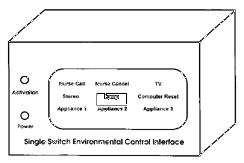 The
Thumb Control is a single switch input environmental control interface for an
inpatient veteran with a brain stem injury. The user controls the system's
operation with a glove-mounted microswitch. The interface then operates the
nurse call, television, stereo, lamp, and computer. This system provides backup
to a commercial environmental control system (Ke:NX by Don Johnston) which is
used to run Macintosh computer programs, communicate with family and staff, and
access the Internet and World Wide Web. The main unit resides on an over-bed
table, has a backlit LCD display for night operation, and is constructed around
an inexpensive battery-powered microcontroller. Unique features of this device
include user control over many of its operational parameters including scan
rate, dwell time, and audio feedback as well as its ability to reboot the
Macintosh and activate the nurse call in the event of a computer failure. While
this initial prototype is a dedicated unit for a specific individual, its
features can be generalized for use by others and incorporated into future
commercial units.
Figure - Thumb Control Environmental Control
Interface.
|
Ultrasonic Head Control Interface
Jaffe
The Ultrasonic Head Control Unit is an interface serving people without
control of their arms or legs. The user's head position is calculated from
ranging data provided by two Polaroid ultrasonic transducers. The head position
information is then used for the realtime control of an electric wheelchair or
a computer's mouse. Tilts of the user's head off the vertical axis
(forward-backward, left-right) operate the wheelchair or move the screen
cursor. The primary advantage of this device is that it requires no mechanical
contact between the transducers and the user's head. The user, therefore, does
not feel "wired up". The interface is intuitive to use, unobtrusive,
cosmetically pleasing, and socially acceptable. Within the VA, the Technology
Transfer Section in Baltimore has completed a nationwide clinical study of
commercial prototype wheelchairs equipped with the interface (from Eureka Labs
in Sacramento) and is now funding a cooperative effort with the Cerebral Palsy
Research Foundation of Kansas to move this technology to the marketplace.
ERGO Knife
Kenney, LeBlanc, Anderson
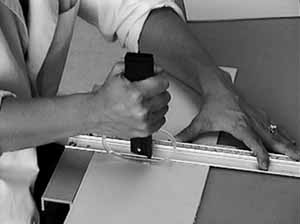 The ERGO Knife is an ergonomic replacement for
the utility knife. Its design alleviates the often uncomfortable and tiring
positions of a regular utility knife and allows safe and easy cutting of flat
materials, even while seated. The ERGO knife is ideal for cutting heavy duty
materials such as cardboard. Originally designed to aid therapists in cutting
splint plastic, it also fits a variety of industrial applications and home
needs for both able bodied and disabled users. Corporate partners are currently
being sought for commercialization of this product.
Figure - The ERGO knife cutting a plastic
sheet
|
SkillSet Office Tools
Vargas, Anderson, Denney, O'Leary
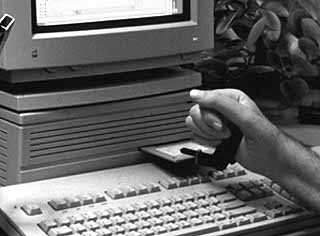 SkillSet is a family of inexpensive tools that
help people with limited hand function work effectively in the modern office
environment. Included are devices for handling diskettes, papers, paper clips,
file folders, paperfolding, and staple removing. SkillSet can enhance the
productivity and independence of office workers, professionals, students -
anyone who works with documents or computers. Each tool in the SkillSet is
designed around a specific task, making it easy to build customized tool kits.
SkillSet tools work with standard office equipment and supplies, making them an
attractive investment for employers wishing to meet ADA requirements
cost-effectively.
Clinical testing in the Spinal Cord Injury Service will assess SkillSet's
usefulness and market potential. Commercial partners are being sought to
manufacture and distribute SkillSet.
Figure - SkillSet's diskette handling tool
|
Beverage Dispenser
Anderson, O'Leary
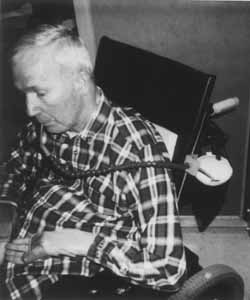 Persons with quadriplegia typically do not
have use of their arms or hands so they depend on others to help them drink.
This is a labor intensive task for caregivers and can diminish the user's
independence and self esteem.
The Beverage Dispenser provides individuals with quadriplegia a means to
drink on their own. The dispenser consists of two major pieces. The first is a
cloth bag that holds a closed beverage container and hangs by straps on the
back of the user's wheelchair, out of the way. The gravity support prevents
spills when the chair is reclined. The second element is a fully adjustable
piece of plastic tubing that supports the straw from the beverage container to
the vicinity of the user's mouth. The caregiver only has to load the cloth bag
with the beverage of choice and position the tubing. The product is currently
in the field evaluation stage. Upon successful completion of clinical trials,
the product design will be offered to manufacturer/marketing vendors for
commercialization.
Figure - The beverage dispenser mounted on the
back of the wheelchair.
|
Crutch Caddies
LeBlanc, Kenney
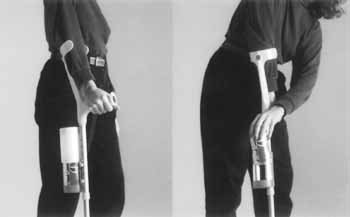 When using forearm crutches, people with
mobility impairments have difficulty carrying objects such as papers, soda
cans, keys, etc. Although canvas bags for underarm crutches with double
uprights are already commercially available, there are no such products for
forearm crutches. We have developed crutch caddies which clip onto the tubular
upright of the forearm crutch.to allow these users to carry personal objects.
One caddy version is flat to carry papers; another is round to carry soda cans.
After clinical testing, a technology transfer effort will seek to bring the
crutch caddies to market.
Figure - The Crutch Caddy is mounted on a
forearm crutch.
|
Wheelchair Rear-view Mirror
Schwandt, Anderson, Farey
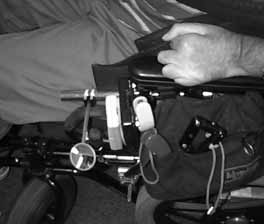 A wheelchair rear-view mirror serves
individuals who have difficulty looking behind them while backing up. The
mirror is compact and unobtrusive, yet provides the user with vision toward the
rear of the wheelchair, especially directly behind the large wheels. The convex
mirror provides a wider field of vision than a flat mirror. Initial prototyping
focused on the selection of a small mirror and on methods of attaching it to
the wheelchair. A two inch diameter adhesive-backed convex mirror, commonly
added to automobile side mirrors was purchased. Originally, the mirror was
attached to the wheelchair using dental accessory tubing which could be shaped
by hand to position the mirror correctly. Two small, black, Delrin blocks were
machined to hold each end of the adjustable tubing, one block adhering to the
back of the mirror with adhesive, and the other attaching to the wheelchair
frame tube with wire ties. Although the dental accessory tubing was found to be
too flexible, subject to vibration, and unable to hold its shape, commercially
available bike helmet mirrors proved to be easily adaptable to the task. This
design is currently being evaluated by wheelchair users in the Rehab R&D
Center and Spinal Cord Injury Service.
Figure -A small adjustable rearview mirror
mounts to a wheelchair's frame tube.
|
Boat Access Gangway
Schwandt, Anderson
The DDP, while evaluating the process of orphan product development, became
aware of a unique accessibility problem.
People who live and work onboard a boat often require a high degree of
physical dexterity and strength to board and disembark; an ability often lost
after a disabling event. A veteran who suffered a stroke had a wooden staircase
built which sat beside his cabin cruiser and allowed him access to his boat.
But because the staircase could not go onboard, he could only leave his boat at
its home dock where the staircase was permanently located. A gangway that could
be attached to the captain's boat, carried aboard, and be deployed at any dock
would enable him to disembark at any port that he visited.
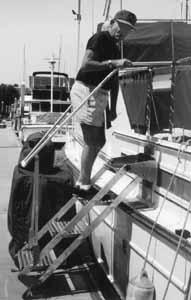 A four step, four bar linkage aluminum
staircase was designed and built. The stair treads are twenty inches wide and
twelve inches deep, allowing full, stable support of the captain's feet in the
event he needs to rest on any stair step. The four bar linkage attaches to a
yoke that pivots on a fixed plate secured to the boat. The entire gangway can
be lifted to a horizontal position and rotated ninety degrees counterclockwise
to a stowed and securely fastened position on the aft side of the boat. This
process takes only a few minutes. Initial results from the field evaluation of
the gangway have demonstrated satisfactory operation in several locations where
the boat has docked. The captain continues to live and work onboard the boat,
but no longer feels trapped at dockside.
Because it is an orphan product and it is unlikely that a manufacturer would
commercialize it, our intention is to make the design drawings available to
others who could benefit from it. We will evaluate the response to offering the
product on a do-it-yourself basis and determine whether the approach is merited
for future projects. While the Rehab R&D Center does not routinely develop
devices for individual patients, projects like this provide valuable insight
into factors that must be considered when designing products for larger
populations of persons with disabilities.
Figure - A stowable stairway provides boat
access to individuals with limited mobility.
|
Method and Apparatus for Cyclocentric Ergometer
Exercise
Brown
There are many exercise devices that are used to strengthen lower extremity
muscles. It is important to find exercises for increasing strength in
functional weight-bearing tasks such as walking, running, and jumping while
minimizing the damage to joints that may occur with repetitive training of
these tasks. Currently available bicycle ergometers, although a good exercise
for minimizing joint loading stress, all involve some seating mechanism that
absorbs most of the body weight forces so that weight-bearing onto the
extremity is minimized. A Cyclocentric Ergometer Exercise (CEE) unit is under
development that overcomes many disadvantages of currently available devices.
CEE possesses a wide range of commercial properties. Since it is easy to use
and can provide training challenges to athletes as well as disabled persons, it
may be made available to the general gym workout market, home exercise market,
and the clinical rehabilitation market. Potentially, anyone interested in leg
strengthening exercises could benefit from using CEE.
Positioning and Transfer of Acute Spinal Cord Injury
Patients
Sabelman, Wilmot, Werner
The goal of this project was to design, fabricate, and test in laboratory
and clinical settings equipment to improve stabilization of cervical spinal
cord injury (SCI) patients during transport. SCI patients are exposed to risk
of further injury by unintentional spinal motion during transport by helicopter
to a specialized spinal center and during routine nursing, therapeutic, and
diagnostic procedures in the hospital.
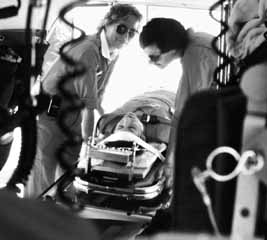 We have designed an x-ray compatible carbon
fiber composite backboard and acceleration-independent cervical traction unit
for transporting SCI patients. Backboard/ traction systems have been in
clinical use since February, 1985, by the Stanford/Life-Flight for
inter-hospital helicopter transport and by Santa Clara Valley Medical Center
Dept. of Physical Medicine & Rehabilitation for in-hospital transport, and
since July, 1991, by REACH/MediPlane aeromedical transport service in Santa
Rosa, CA. Users report only minor problems related to counter-traction,
cleaning, and traction unit height adjustment. We are exploring collaboration
possibilities with the US Air Force Armstrong Laboratory, Brooks AFB, TX, in
setting design and test specifications for a new generation of equipment for
long-distance evacuation of military SCI casualties.
Figure - Loading (simulated) SCI patient in
traction on board BK-117 helicopter.
|
Implantable Fingertip Touch Sensation Prosthesis
Sabelman, Hentz
Loss of touch and pressure sensation may occur as a result of spinal cord
injury, brachial plexus trauma, diabetes or Hansen's disease. In order to
provide protective sensation and closed-loop servocontrol of grasp force, we
have studied preferred anatomical sites for implantable rather than externally
mounted touch sensors. We subsequently constructed mock-up sensors small enough
to be implanted, and built breadboard large-scale circuits for getting power to
and touch signals from implanted sensors.
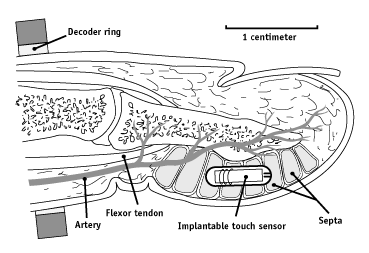 The state-of-the-art of implantable sensors
has advanced to the point that transducers can be encased in glass tubes small
enough to inject through a large-bore hypodermic needle. This is essentially
the technology we propose to adapt: the pressure-sensing diaphragm, signal and
excitation voltage-conditioning circuits and output transmitter will be
constrained to fit within a 2 to 3 mm OD tube of less than 10 mm length. A
scaled-up working circuit which included the pressure sensor, amplifier,
transponder and antenna was built. Inductive transmission of power into the
circuit was also demonstrated. Other power input and signal output transmission
modes were explored, including direct wiring, radio frequency,and infrared.
Figure - Implantable pressure sensor model
showing location within fingertip.
|
Ralph Fingerspelling Hand
Jaffe, Schwandt, Anderson
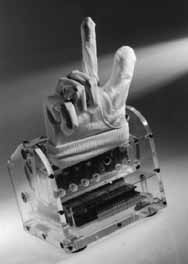 Ralph is a computer controlled
electromechanical hand that serves as a tactile display for persons who are
deaf and blind. In operation, the deafblind user feels the hand as it moves and
interprets its motions as letters corresponding to the American One-Hand Manual
Alphabet, a technique known as tactile fingerspelling. The hand is controlled
by a microcontroller whose software translates incoming serial ASCII data into
control signals that operate eight servo motors. These servo motors pull on the
fingers' mechanical linkages causing them to flex. Ralph can use information
from a computer's serial port, modem, TDD, or computer interface to a optical
character recognition scanner, voice recognition system, closed caption
decoder, or stenography machine facilitating translation of e-mail, telephone
conversations, printed text, spoken words, subtitled television programs, or
classroom/conference/courtroom interactions into fingerspelling.
Commercialization of this technology is being pursued through collaborations
with an electronics company and a national research laboratory.
Figure - Ralph fingerspelling hand
|
Republished from the 1996 Rehabilitation R&D Center Progress Report.










